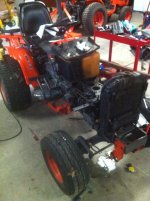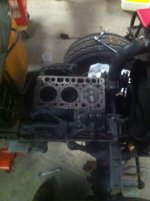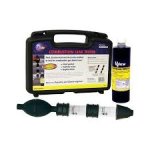Kenonf
Bronze Member
Hi,
I have a B7100 HST and it is a thermosiphon type, 5000+ hours, I lost the first hour meter....
I guess I blew the head gasket about 3 years ago, and figured it out about a year ago, because it kept dumping antifreeze out of the overflow hose.
I did a compression and test and one was low, So I replaced the head gasket. Machinist removed .001" of and inch to get back to flat, commented that it was in great shape. and I put it back together.
About a month ago I look and the radiator is low, hmmm. I add anti freeze and watch for bubbles while running, dam bubbles again. Worth mentioning my son did stall the tractor a couple of times while mowing.
So, I buy a new head gasket and o-ring and RnR the head gasket again. The cylinder closest to fan has a lot of carbon on cylinder, thought we had a cracked piston. Cleaned carbon off and every thing looks great.
I put it all back together and run, dam bubbles in radiator.
A week goes by, pull out compression tester and remove injectors, first cylinder closest to has a little carbon on injector, so either low pressure or bad injector... got that.
Cold engine, got down to about 38 degrees F here last night, poured a little 15w-40 into the cylinders and gave it a spin, after about 5 sec I get a little smoke from the injector holes. screw in the tester and about 500 in first cylinder, and about 475 in the other two. I let each of them sit at pressure (about 20 min) to see if there is any pressure loss, none.
Now what....?
I was going to bring it into town and get the fuel pump tested and fixed and a new set of injectors.
Why am i getting a few bubbles on the radiator...could it be I had trapped air in system after RnR and they were just working themselves out.
Do I need to put it back together and run till hot and check compression, or was cold and oil enough?
Just a novice diesel repair tech but wiling to try.
Thank you,
Ken
I have a B7100 HST and it is a thermosiphon type, 5000+ hours, I lost the first hour meter....
I guess I blew the head gasket about 3 years ago, and figured it out about a year ago, because it kept dumping antifreeze out of the overflow hose.
I did a compression and test and one was low, So I replaced the head gasket. Machinist removed .001" of and inch to get back to flat, commented that it was in great shape. and I put it back together.
About a month ago I look and the radiator is low, hmmm. I add anti freeze and watch for bubbles while running, dam bubbles again. Worth mentioning my son did stall the tractor a couple of times while mowing.
So, I buy a new head gasket and o-ring and RnR the head gasket again. The cylinder closest to fan has a lot of carbon on cylinder, thought we had a cracked piston. Cleaned carbon off and every thing looks great.
I put it all back together and run, dam bubbles in radiator.
A week goes by, pull out compression tester and remove injectors, first cylinder closest to has a little carbon on injector, so either low pressure or bad injector... got that.
Cold engine, got down to about 38 degrees F here last night, poured a little 15w-40 into the cylinders and gave it a spin, after about 5 sec I get a little smoke from the injector holes. screw in the tester and about 500 in first cylinder, and about 475 in the other two. I let each of them sit at pressure (about 20 min) to see if there is any pressure loss, none.
Now what....?
I was going to bring it into town and get the fuel pump tested and fixed and a new set of injectors.
Why am i getting a few bubbles on the radiator...could it be I had trapped air in system after RnR and they were just working themselves out.
Do I need to put it back together and run till hot and check compression, or was cold and oil enough?
Just a novice diesel repair tech but wiling to try.
Thank you,
Ken


